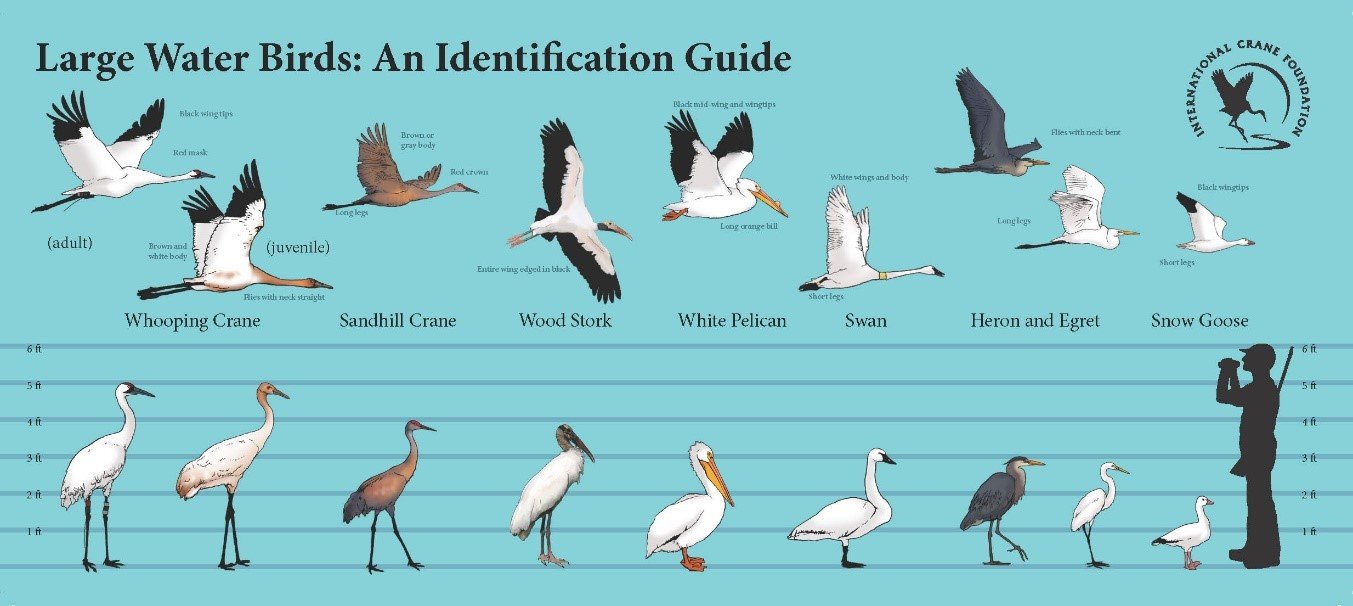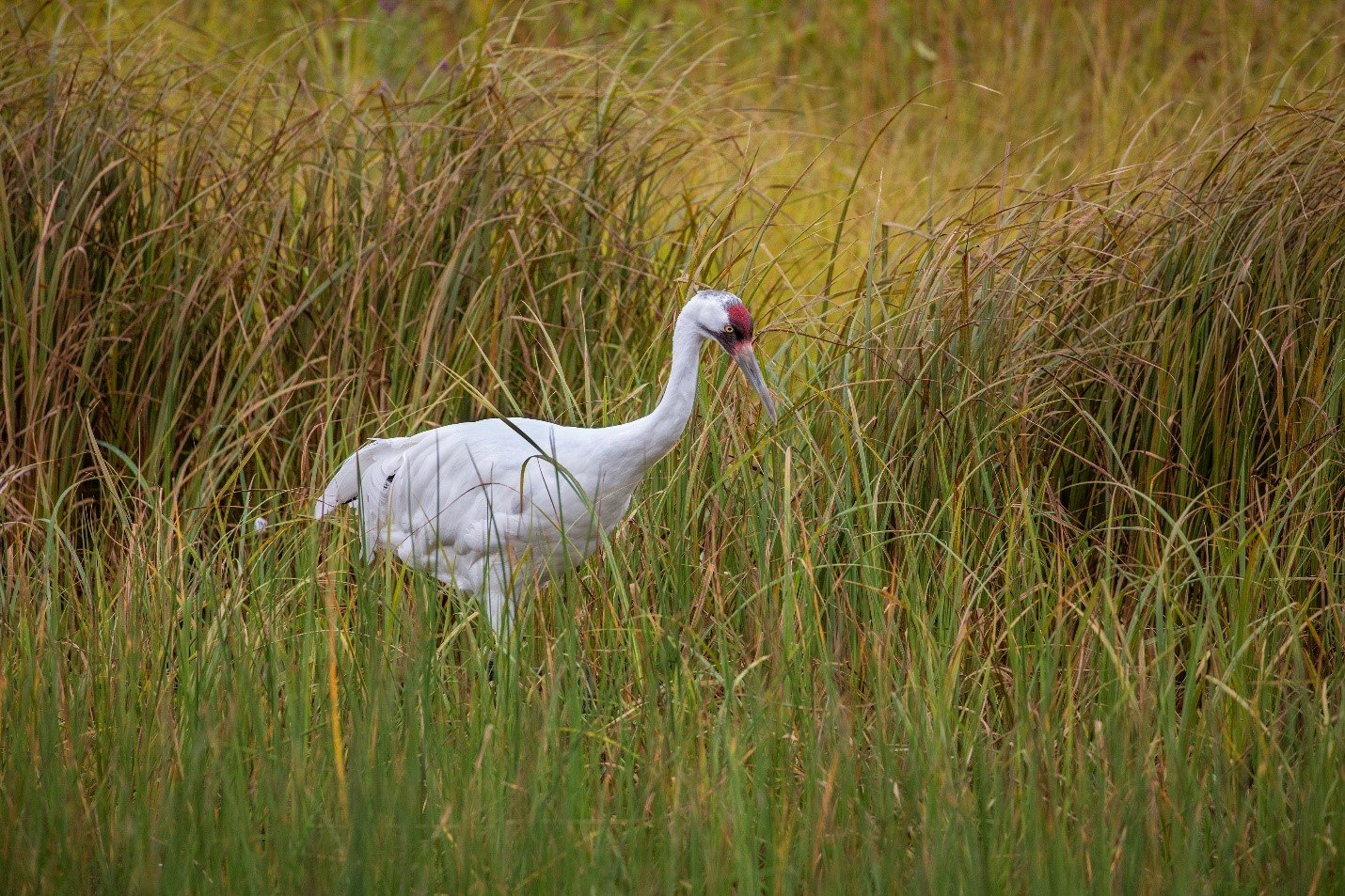By Stephanie Schmidt, Whooping Crane Outreach Coordinator for the International Crane Foundation (sschmidt@savingcranes.org)
This article originally appeared in Wisconsin Waterfowl Association’s June, 2022 Newsletter edition.
Editor’s note: As part of our ongoing information on cranes, we are pleased to publish this whooping crane article, written by International Crane Foundation’s Stephanie Schmidt. Stephanie contacted us to identify opportunities to reach waterfowlers on this topic. In addition to this article, we also offered her an opportunity to set up a booth at the upcoming Waterfowl Hunters EXPO at the end of August. You may also be seeing some of the ICF’s Large Waterbird Identification Guide there and at some of our events if you would like to have one.
While WWA and ICF may be on different sides of a sandhill crane hunt question, we share a desire to see the whooping crane population continue its rebound. In states where sandhill cranes are hunted, hunters must take training intended to ensure they don’t misidentify and shoot a whooper. To date, this training has been proven 100% effective, with no documented instance of a whooper shot after being mistaken for a sandhill. In our work with legislators to refine the sandhill hunt legislation that was proposed last session, WWA encouraged considering further measures to protect the fragile whooper population, such as timing a sandhill hunt before the staging period where whoopers typically begin to mingle with sandhills.

If you spot a Whooping Crane in Wisconsin, look for their bands and report your sighting at bandedcranes.org. International Crane Foundation photo.
Anytime a whooper is shot, sportsmen everywhere know that action was illegal and unethical. But the non-hunting public may still associate that illegal action with hunting, which, however unfair, hurts our community of hunter land stewards. I encourage you to fully absorb Stephanie’s message, and click through to the study of whooper killings ICF did a few months ago.
Wisconsin’s wetlands are home to one of the rarest birds in North America, the Whooping Crane. Whooping Cranes are a large white wetland dependent bird, and standing at 5 feet tall, they are North America’s tallest bird. They have long black legs which keep their body above the waterline as they wade through wetlands, and their body and long neck are almost entirely white except for their prominent black wingtips and their facial markings. On their face, they have a black moustache-like mask, a featherless red crown, and a long gray beak that is more yellow towards the base. In flight, Whooping Cranes will fly with their long neck outstretched and their long legs trailing behind them, and here you can see their black wing tips on display. Additionally, in Wisconsin most Whooping Cranes will have colorful leg bands or telemetry devices on their legs which allows scientists to monitor the growing population of Whooping Cranes in our state.

While uncommon on the landscape, many common waterbirds share features with Whooping Cranes and can often be misidentified as one. International Crane Foundation photo.
As a steward of wetlands, you may be familiar with the story of the Whooping Crane. You may even have been fortunate enough to spot this impressive and ancient bird, perhaps through the dense cattail, or hear its bugling call across the marsh. Though Whooping Cranes were never numerous and there were only an estimated 10,000 Whooping Cranes in North America before European settlement, some may have bred in the fertile wetlands found here in Wisconsin. However, by the 1940’s, following rapid habitat loss and degradation, unregulated hunting, and egg collecting, only 20 Whooping Cranes remained in the wild and they were completely extirpated from a majority of their breeding areas in North America and faced the threat of extinction. Today, thanks to the efforts of wetland stakeholders and the International Crane Foundation and other crane conservation partners, Whooping Cranes have returned to Wisconsin and their populations are slowly rebuilding.

A Whooping Crane is seen through tall wetland grasses. the International Crane Foundation photo.
Today, there are over 650 wild Whooping Cranes across North America, and between March and November, around 80 of them will call Wisconsin home and will nest and raise their chicks here. While in Wisconsin, Whooping Cranes can be found in marshes as well as agricultural fields near their breeding wetlands. Whooping Cranes are protected by the Migratory Bird Treaty Act and the Endangered Species Act, which makes it illegal to harm or disturb them. Those who do face fines, jail time, and/or a revocation of their hunting license. However, Whooping Cranes continue to face threats from poaching; more information can be found here. For these laws to work, Whooping Cranes need ambassadors on the ground who can protect them from threats and report instances of poaching or harassment. As stewards of our wetlands and protectors of Wisconsin’s natural heritage, Whooping Cranes are dependent on you to safeguard their future in Wisconsin.
To protect Whooping Cranes in Wisconsin, we are asking that you, and those you know or mentor, continue to be responsible hunters and be the eyes and ears on the ground for Whooping Cranes by continuing to follow legal hunting regulations and confirming an animal is legal game and not a Whooping Crane before shooting. In addition, if you see Whooping Cranes, please report your observation to www.bandedcranes.org and notify new hunters who may be unfamiliar with these birds that there are Whooping Cranes in the area. Finally, we ask that you report any suspicious activity or activity that appears to disturb or harm Whooping Cranes to 1-800-TIP-WDNR (1-800-847-9367). Using this confidential tip line greatly increases game wardens’ abilities to effectively protect Whooping Cranes and hold poachers responsible.
If you have any questions about Whooping Cranes or are seeking additional information on how to better protect them in Wisconsin, please head to our website, www.savingcranes.org, or send us an email with your questions to info@savingcranes.org. We appreciate your continued support to protect Wisconsin’s wetlands and native species.
